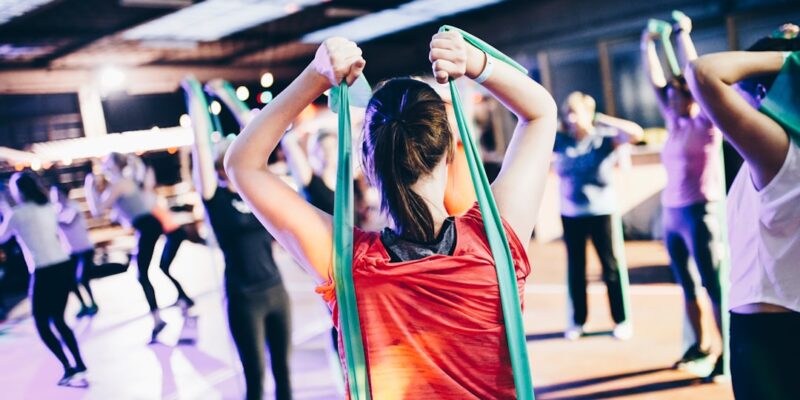
Get Ripped with Push Up Bar Workout: The Ultimate Guide to Sculpting Your Upper Body
Push up bars are a simple yet effective tool that can greatly enhance your upper body workouts. They provide a stable and elevated platform for performing push ups, allowing you to target specific muscle groups more effectively. Whether you are a beginner or an advanced fitness enthusiast, push up bars can help you improve your strength, form, and overall performance.
One of the key benefits of using push up bars is that they allow for a greater range of motion compared to traditional push ups. By elevating your hands off the ground, push up bars enable you to lower your chest closer to the floor, engaging your muscles more intensely. This increased range of motion helps to activate more muscle fibers in your chest, shoulders, and arms, leading to greater strength gains and muscle development.
Key Takeaways
- Push up bars are essential for upper body workouts as they provide a greater range of motion and engage more muscles.
- Using push up bars can improve upper body strength, increase muscle definition, and reduce strain on the wrists.
- When choosing push up bars, consider factors such as grip, stability, and adjustability to match your fitness goals.
- Top push up bar exercises include standard push ups, diamond push ups, and decline push ups for targeting different muscle groups.
- Advanced push up bar variations such as plyometric push ups and one-arm push ups can challenge your muscles and improve endurance.
The Benefits of Using Push Up Bars for Upper Body Strength Training
Using push up bars offers several advantages over traditional push ups. Firstly, they help improve form by keeping your wrists in a neutral position. When performing push ups on the floor, your wrists are forced into an extended position, which can lead to discomfort and strain. Push up bars alleviate this issue by allowing your wrists to remain in a more natural alignment, reducing the risk of injury.
Additionally, push up bars can help reduce strain on the shoulders. When performing push ups on the floor, your shoulders are placed in a vulnerable position as they bear the brunt of the load. By using push up bars, you can distribute the weight more evenly across your upper body, relieving some of the stress on your shoulders.
Push up bars also target specific muscle groups more effectively. While traditional push ups primarily work the chest, shoulders, and triceps, push up bars allow for variations that engage other muscles as well. For example, by widening your hand placement on the bars, you can target your chest muscles even more. Conversely, by bringing your hands closer together, you can shift the focus to your triceps. This versatility makes push up bars a valuable tool for sculpting and strengthening your upper body.
How to Choose the Right Push Up Bars for Your Fitness Goals
When it comes to choosing push up bars, there are several options available in the market. The most common types include stationary bars, rotating bars, and portable bars. Each type has its own advantages and considerations, so it’s important to choose the right one based on your fitness goals and preferences.
Stationary push up bars are the most basic and affordable option. They provide a stable platform for performing push ups and are suitable for beginners or those who prefer a more traditional approach. However, they lack the rotational feature that some individuals may find beneficial for engaging additional muscles and improving stability.
Rotating push up bars, on the other hand, offer a more dynamic workout experience. These bars have a rotating base that allows your hands to move freely as you perform push ups. This rotation engages more muscles in your core and stabilizer muscles, providing a greater challenge and helping to improve balance and coordination.
Portable push up bars are designed for convenience and versatility. They are lightweight and compact, making them easy to carry and use anywhere. Portable push up bars often have adjustable height settings, allowing you to customize the intensity of your workouts. These bars are ideal for individuals who travel frequently or prefer to exercise at home.
When selecting push up bars, there are a few key features to consider. Look for bars that have a comfortable grip with non-slip padding or handles. This will ensure a secure grip during your workouts. Additionally, choose bars that are sturdy and durable to withstand your body weight and repetitive use. Finally, consider the size and portability of the bars if you plan on using them in different locations or storing them when not in use.
The Top Push Up Bar Exercises for Sculpting Your Chest, Shoulders, and Arms
| Exercise Name | Muscles Worked | Difficulty Level | Repetitions |
|---|---|---|---|
| Standard Push Up | Chest, Shoulders, Triceps | Beginner | 3 sets of 10-15 reps |
| Close Grip Push Up | Triceps, Chest, Shoulders | Intermediate | 3 sets of 10-15 reps |
| Wide Grip Push Up | Chest, Shoulders, Triceps | Intermediate | 3 sets of 10-15 reps |
| Decline Push Up | Upper Chest, Shoulders, Triceps | Advanced | 3 sets of 10-15 reps |
| Spiderman Push Up | Chest, Shoulders, Triceps, Obliques | Advanced | 3 sets of 10-15 reps |
Push up bars offer a wide range of exercises that can target different muscle groups in your upper body. Here are some of the best push up bar exercises for sculpting your chest, shoulders, and arms:
1. Standard Push Up: Place your hands shoulder-width apart on the bars and assume a plank position. Lower your chest towards the bars while keeping your body straight. Push back up to the starting position. This exercise primarily targets the chest, shoulders, and triceps.
2. Wide Grip Push Up: Position your hands wider than shoulder-width apart on the bars. Lower your chest towards the bars while maintaining a straight body alignment. Push back up to the starting position. This variation places more emphasis on the outer chest muscles.
3. Close Grip Push Up: Bring your hands closer together on the bars, forming a diamond shape with your thumbs and index fingers. Lower your chest towards the bars while keeping your elbows close to your body. Push back up to the starting position. This exercise targets the triceps and inner chest muscles.
4. Decline Push Up: Place your feet on an elevated surface, such as a bench or step, and assume a push up position with your hands on the bars. Lower your chest towards the bars while keeping your body straight. Push back up to the starting position. This variation increases the intensity by placing more weight on the upper body.
5. Incline Push Up: Position the bars at a lower height and place your hands on them with your feet on the ground. Lower your chest towards the bars while maintaining a straight body alignment. Push back up to the starting position. This exercise targets the lower chest muscles.
6. Pike Push Up: Assume a downward dog position with your hands on the bars and your hips raised towards the ceiling. Lower your head towards the bars by bending your elbows, then push back up to the starting position. This exercise primarily targets the shoulders and upper back.
7. Spiderman Push Up: Perform a standard push up while bringing one knee towards your elbow on the same side. Alternate sides with each repetition. This variation engages the core muscles and improves stability.
8. Archer Push Up: Assume a wide grip push up position on the bars. Lower your chest towards one hand while keeping the other arm straight. Push back up to the starting position and repeat on the other side. This exercise targets the chest, shoulders, and arms asymmetrically.
Each of these exercises can be modified to suit your fitness level and goals. Start with a comfortable number of repetitions and gradually increase as you build strength and endurance. Remember to maintain proper form and technique throughout each exercise to maximize results and minimize the risk of injury.
Advanced Push Up Bar Variations for Building Muscle and Increasing Endurance
For those looking to challenge themselves further, there are advanced push up bar variations that can help build muscle and increase endurance. These variations require greater strength, stability, and coordination. Here are some advanced push up bar exercises to consider:
1. One-Arm Push Up: Place one hand on a push up bar and the other hand behind your back. Lower your chest towards the bar while keeping your body straight. Push back up to the starting position. This exercise targets the chest, shoulders, and triceps asymmetrically.
2. Handstand Push Up: Position the bars at a lower height and assume a handstand position with your feet against a wall for support. Lower your head towards the bars by bending your elbows, then push back up to the starting position. This variation primarily targets the shoulders and upper back.
3. Clapping Push Up: Perform a standard push up, but explode off the bars at the top of the movement and clap your hands together before landing back on the bars. This exercise improves explosive power and upper body strength.
4. Plyometric Push Up: Assume a standard push up position on the bars. Lower your chest towards the bars, then explosively push off the bars and into the air, allowing your hands to leave the bars momentarily. Land back on the bars and immediately go into the next repetition. This exercise enhances power, speed, and coordination.
5. L-Sit Push Up: Sit on the floor with your legs extended in front of you and your hands on the bars beside your hips. Lift your body off the ground by pressing through your hands and engaging your core. Lower your chest towards the bars while keeping your legs extended in front of you. Push back up to the starting position. This variation targets the chest, shoulders, triceps, and core muscles.
These advanced variations require a high level of strength and stability, so it’s important to progress gradually and ensure proper form and technique. Start with a lower number of repetitions and gradually increase as you become more comfortable and confident with each exercise.
How to Incorporate Push Up Bars into Your Daily Workout Routine
To incorporate push up bars into your daily workout routine, consider the following tips:
1. Warm up: Before using push up bars, it’s important to warm up your muscles and prepare your body for exercise. Perform dynamic stretches such as arm circles, shoulder rolls, and wrist rotations to increase blood flow and flexibility.
2. Choose a variety of exercises: Select a combination of push up bar exercises that target different muscle groups in your upper body. This will ensure a well-rounded workout and prevent muscle imbalances.
3. Create a workout plan: Determine how many sets and repetitions you will perform for each exercise based on your fitness level and goals. Aim for at least three sets of 8-12 repetitions per exercise.
4. Alternate push up bar workouts with other upper body exercises: To maximize results, incorporate push up bar workouts into a comprehensive upper body training program. Include exercises such as dumbbell presses, rows, and lateral raises to further strengthen and sculpt your muscles.
5. Progress gradually: As you become stronger and more comfortable with push up bar exercises, gradually increase the intensity by adding more repetitions, sets, or advanced variations. This will ensure continued progress and prevent plateauing.
6. Rest and recover: Allow your muscles time to rest and recover between workouts. Aim for at least one day of rest between push up bar sessions to prevent overtraining and promote muscle growth.
Consistency and progression are key when incorporating push up bars into your daily workout routine. Stick to your plan and challenge yourself to improve with each workout. With time and dedication, you will see noticeable improvements in your upper body strength, muscle definition, and overall fitness level.
Tips for Proper Form and Technique When Using Push Up Bars
Maintaining proper form and technique is crucial when using push up bars to prevent injuries and maximize results. Here are some tips to help you maintain proper form:
1. Start with a neutral spine: Begin each exercise with a neutral spine by aligning your head, neck, and spine in a straight line. Avoid arching or rounding your back as this can put unnecessary strain on your spine.
2. Engage your core: Throughout each exercise, engage your core muscles by drawing your belly button towards your spine. This will help stabilize your body and maintain proper alignment.
3. Keep your elbows close to your body: When performing push ups on the bars, keep your elbows close to your body rather than flaring them out to the sides. This will target the chest muscles more effectively and reduce strain on the shoulders.
4. Lower your chest towards the bars: Aim to lower your chest towards the bars while maintaining a straight body alignment. Avoid sagging or piking your hips as this can compromise your form and reduce the effectiveness of the exercise.
5. Push through your palms: As you push back up to the starting position, focus on pushing through your palms rather than your fingertips. This will engage your chest, shoulders, and triceps more effectively.
6. Breathe properly: Inhale as you lower your chest towards the bars and exhale as you push back up to the starting position. This will help oxygenate your muscles and provide them with the necessary energy for the exercise.
7. Listen to your body: Pay attention to any discomfort or pain during your workouts. If something doesn’t feel right, adjust your form or modify the exercise as needed. It’s important to prioritize safety and avoid pushing through pain.
By maintaining proper form and technique, you can maximize the benefits of push up bar exercises and reduce the risk of injury. Take the time to practice each exercise with proper alignment and focus on engaging the target muscles.
The Importance of Warm Up and Stretching Before Push Up Bar Workouts
Before engaging in any physical activity, it’s important to warm up your muscles and prepare your body for exercise. This is especially true when using push up bars, as they require a significant amount of upper body strength and stability. Here’s why warming up and stretching are essential before push up bar workouts:
1. Increased blood flow: Warming up increases blood flow to your muscles, delivering oxygen and nutrients that are essential for optimal performance. This helps to improve muscle function and reduce the risk of injury.
2. Improved flexibility: Stretching before a workout helps improve flexibility by increasing the range of motion in your joints. This allows you to perform exercises with proper form and technique, reducing the risk of strain or injury.
3. Injury prevention: Warming up and stretching before push up bar workouts can help prevent common injuries such as muscle strains, sprains, and joint pain. By preparing your muscles and joints for the demands of exercise, you can minimize the risk of overuse or acute injuries.
4. Enhanced performance: A proper warm up and stretching routine can improve your overall performance during push up bar workouts. By increasing blood flow, flexibility, and muscle activation, you can perform exercises more efficiently and effectively.
To warm up before push up bar workouts, start with 5-10 minutes of light cardio exercises such as jogging, jumping jacks, or cycling. This will increase your heart rate and body temperature, preparing your muscles for more intense activity.
After warming up, perform dynamic stretches that target the muscles you will be using during your push up bar workout. Dynamic stretches involve controlled movements that take your joints through a full range of motion. Examples of dynamic stretches for the upper body include arm circles, shoulder rolls, and wrist rotations.
It’s important to note that static stretching, where you hold a stretch for an extended period of time, is best performed after your workout. This type of stretching helps to cool down your muscles and improve flexibility.
How to Track Your Progress and Set Realistic Goals with Push Up Bar Training
Tracking your progress and setting realistic goals is essential for staying motivated and achieving long-term success with push up bar training. Here are some tips to help you track your progress and set achievable goals:
1. Keep a workout journal: Record each push up bar workout in a journal or on a fitness tracking app. Include details such as the exercises performed, sets, repetitions, and any modifications or variations.
Looking to take your bar workout to the next level? Check out this informative article on Wave Magnets, a revolutionary fitness accessory that can enhance your strength training routine. Whether you’re a beginner or an experienced athlete, Wave Magnets can help you maximize your gains and improve your overall performance. Discover how these innovative magnetic weights can transform your bar workouts by visiting https://wavemagnets.com/. Don’t miss out on this game-changing fitness tool!
FAQs
What are push up bars?
Push up bars are fitness equipment designed to enhance the effectiveness of push up exercises. They are usually made of metal or plastic and have a handle on each end.
What are the benefits of using push up bars?
Using push up bars can help increase the range of motion of push up exercises, engage more muscles in the upper body, and reduce strain on the wrists and hands.
What muscles do push up bar workouts target?
Push up bar workouts primarily target the chest, shoulders, triceps, and core muscles. They also engage the biceps, forearms, and upper back muscles to a lesser extent.
What are some push up bar exercises?
Some popular push up bar exercises include standard push ups, wide grip push ups, close grip push ups, decline push ups, and incline push ups.
Can push up bars be used by beginners?
Yes, push up bars can be used by beginners. However, it is important to start with basic exercises and gradually increase the difficulty level to avoid injury.
Are push up bars suitable for people with wrist pain?
Yes, push up bars can be a good option for people with wrist pain as they reduce the strain on the wrists and distribute the weight more evenly across the hands and forearms.
Can push up bars be used for other exercises?
Yes, push up bars can be used for other exercises such as dips, L-sits, and handstand push ups. They can also be used for stretching and mobility exercises.

















